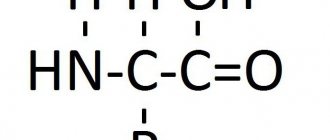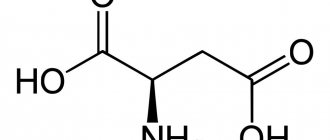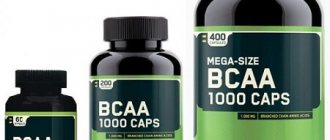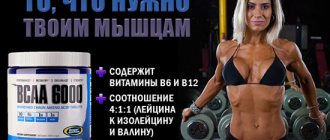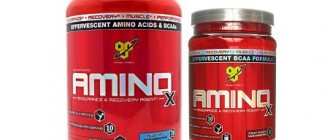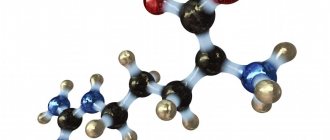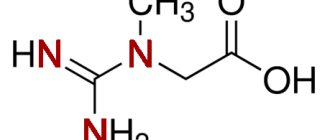Types of amino acids. Their features and purpose. Their main irreplaceable and replaceable varieties. Millions of articles and thousands of books have been written about the importance of amino acids for the human body. Indeed, it is very difficult to overestimate the benefits of organic compounds, which, in fact, are the basis of protein molecules. To better understand the importance of amino acids for the body, it is enough to understand one fact: they are in second place in importance after water.
However, not everyone knows that there are two types of amino acids - essential and non-essential. The former cannot be synthesized by our body (this means that such compounds can only be obtained from food). The second ones can be synthesized from other amino acids or substances entering the body. Moreover, each element has its own formulas and tasks.
Amino acids - what are they?
Amino acids (or aminocarboxylic acids; AMK; peptides) are organic compounds consisting of 16% amines - organic derivatives of ammonium - which distinguishes them from carbohydrates and lipids. They participate in the biosynthesis of protein by the body: in the digestive system, under the influence of enzymes, all proteins supplied with food are destroyed to AMC. In total, there are about 200 peptides in nature, but only 20 basic amino acids are involved in the construction of the human body, which are divided into replaceable and essential; sometimes there is a third type - semi-replaceable (conditionally replaceable).
Amino acids
Amino acids are monomers consisting of hydrocarbon, nitrogen and oxygen. Some compounds contain sulfur, phosphorus and some other elements. These are derivatives of carboxylic acids with the -COOH group. One amino acid can contain several amino groups.
Rice. 1. Structure of amino acids.
Amino acids are crystalline compounds that are soluble in water. They exhibit amphoteric properties and can react with inorganic substances - oxygen, water, acids, alkalis.
Amino acids form polymers - proteins, which can consist of various monomers. For example, casein includes tyrosine, lysine, valine, proline and other amino acids.
Nonessential amino acids
Replaceable amino acids are those that are both consumed in food and reproduced directly in the human body from other substances.
- Alanine is a monomer of a large number of biological compounds and proteins. It carries out one of the main pathways of glucogenesis, that is, it is converted into glucose in the liver, and vice versa. A highly active participant in metabolic processes in the body.
- Arginine is an amino acid that can be synthesized in the body of an adult, but is not capable of synthesis in the body of a child. Promotes the production of growth hormones and others. The only carrier of nitrogenous compounds in the body. Helps increase muscle mass and reduce fat mass.
- Asparagine is a peptide involved in nitrogen metabolism. During the reaction with the enzyme asparaginase, it splits off ammonia and turns into aspartic acid.
- Aspartic acid - takes part in the creation of immunoglobulin, deactivates ammonia. Necessary for malfunctions of the nervous and cardiovascular systems.
- Histidine – used for the prevention and treatment of gastrointestinal diseases; has positive dynamics in the fight against AIDS. Protects the body from the harmful effects of stress.
- Glycine is a neurotransmitter amino acid. Used as a mild sedative and antidepressant. Enhances the effect of some nootropic drugs.
- Glutamine is a large part of hemoglobin. Activator of tissue repair processes.
- Glutamic acid – has a neurotransmitter effect and also stimulates metabolic processes in the central nervous system.
- Proline is one of the components of almost all proteins. They are especially rich in elastin and collagen, which are responsible for skin elasticity.
- Serine is an amino acid that is found in neurons of the brain and also contributes to the release of large amounts of energy. It is a derivative of glycine.
- Tyrosine is a component of animal and plant tissues. Can be reproduced from phenylalanine by the action of the enzyme phenylalanine hydroxylase; the reverse process does not occur.
- Cysteine is one of the components of keratin, which is responsible for the firmness and elasticity of hair, nails, and skin. It is also an antioxidant. Can be produced from serine.
Types and features
Today, 20 basic amino acids can be distinguished. Of these, 9 are essential and 11 are nonessential amino acids. Let's look at some of them in more detail.
Essential amino acids:
- Histidine (His, H) is found in the tissues of our body. Its main functions include participation in the creation of red and white blood cells, organization of data exchange between peripheral tissues and the nervous system. Histidine is the basis for creating a strong immune system. It is involved in the formation of gastric juice and the normalization of the digestive process. The peculiarity of these amino acids is their rapid consumption, so they need constant replenishment.
- Isoleucine (Ile, I) is classified as essential and is one of the 20 most beneficial amino acids for athletes. Its main function is to increase the athlete’s endurance, aid in recovery, and participate in energy production.
- Leucine (Leu, L) plays a major role in the process of muscle fiber recovery. Its special properties include the ability to convert it into glucose, which allows you to stop catabolic processes in the body. In addition, leucine takes part in the restoration of muscle fibers, regulation of sugar levels and burning of fat deposits.
- Lysine (the table of amino acids reflects it as - Lys, K) is known for its talents in the fight against viral diseases. With its active participation, antibodies are synthesized that participate in strengthening the immune system, regulate the growth of muscle fibers and renew bone tissue. With the help of lysine, the body quickly copes with herpes infections and colds.
- Methionine (Met, M) is one of the 20 most important essential amino acids. Provides all possible assistance in the fight against excess fat deposits. Participates in the production of taurine, cysteine and glutathione. In addition, methionine plays an active role in the synthesis of creatine, which directly improves muscle strength and endurance.
- Phenylalanine (the table of chemical compounds displays it as Phe, F) - normalizes the functioning of the athlete’s nervous system, helps fight chronic pain, and treats various neurological diseases. Taking this amino acid helps improve memory and mood. Often used to treat schizophrenia and Parkinson's disease.
- Threonine (Thr, T) - of 20 amino acids, is considered one of the most important for the growth of muscle fibers, the formation of elastin and collagen. The functions of threonine include normalizing protein metabolism and stimulating muscle development. In addition, this amino acid supports almost all the main systems of the body - immune, nervous, and so on.
- Tryptophan (Trp, W) belongs to the category of essential. Actively participates in the production of serotonin and methionine. Improves sleep, regulates the respiratory system and normalizes blood pressure.
- Valine (Val, V) is one of the best among 20 amino acids. Takes part in tissue restoration, supplies the body with the necessary energy, and prevents catabolic processes from developing. Valine normalizes muscle activity and helps in the treatment of a number of diseases of the brain and liver.
Essential amino acids:
- Alanine (Ala, A) is also among the 20 most essential compounds for the body. These non-essential amino acids are a powerful source of energy and an accelerator of the processes of removing toxins from the liver. Alanine prevents the breakdown of muscle tissue and prolongs the life of cells.
- Arginine (the table of amino acids reflects it as Arg, R) is rightfully in the 20 best amino acids. Arginine is necessary for normalizing liver function, maintaining muscles and skin in ideal condition. It has powerful restorative properties, participates in strengthening the immune system, and improves metabolism.
- Asparagine (Asn, N) belongs to the category of “essential amino acids”. Has a tight bond with aspartic acid. It is actively used for the synthesis of ammonia.
- Aspartic acid (Asp, D) takes pride of place in the 20 most essential chemical compounds. Its advantages include normalization of metabolic processes, activation of cellular energy synthesis, and support of the nervous system.
- Cysteine (Cys, C) – belongs to the category of “essential amino acids”. Participates in normalizing the structure of hair, nails and skin. Helps in the fight against cancer, bronchitis, septic shock.
- Glutamine (Gln, Q) effectively removes toxins from the liver and is involved in muscle growth. Helps increase energy, gives additional strength and endurance.
But these are not all non-essential amino acids. It is worth highlighting proline (stimulates collagen synthesis), glycine (participates in the construction of muscle tissue and helps gain muscle mass), proline (accelerates tissue healing), serine (supports the functioning of the central nervous system and brain) and tyrosine (promotes the restoration of the entire body).
Amino acids that cannot be synthesized in the body are essential
Essential amino acids are those that cannot be generated in the human body and can only be supplied through food.
- Valine is an amino acid found in almost all proteins. Increases muscle coordination and reduces the body's sensitivity to temperature changes. Maintains the hormone serotonin at high levels.
- Isoleucine is a natural anabolic steroid that, through the process of oxidation, saturates muscle and brain tissue with energy.
- Leucine is an amino acid that improves metabolism. It is a kind of “builder” of protein structure.
- These three AMKs are part of the so-called BCAA complex, which is especially in demand among athletes. Substances in this group act as a source for increasing muscle mass, reducing fat mass and maintaining good health during particularly intense physical activity.
- Lysine is a peptide that accelerates tissue regeneration, the production of hormones, enzymes and antibodies. Responsible for the strength of blood vessels, found in muscle protein and collagen.
- Methionine – takes part in the synthesis of choline, the lack of which can lead to increased accumulation of fat in the liver.
- Threonine – gives elasticity and strength to tendons. It has a very positive effect on the heart muscle and tooth enamel.
- Tryptophan – supports emotional state, as it is converted into serotonin in the body. Indispensable for depression and other psychological disorders.
- Phenylalanine – improves the appearance of the skin by normalizing pigmentation. Supports psychological well-being by improving mood and bringing clarity to thinking.
How to choose the right amino acids
Amino acids in the form of bioactive supplements for sports nutrition, as a rule, are not cheap.
And in order not to throw money away, it is important to check the quality of the product before purchasing. The first thing you should pay attention to is the expiration date and quality of packaging; the consistency and color of the substance must fully correspond to the description. In addition, most amino acids are water soluble and have a bitter taste. Essential amino acids: comparison table
| Amino acid | Application | Dosage (as a dietary supplement for athletes) | Overdose; Shortage | Sources |
| Histidine | Treats arthritis, nerve deafness, improves digestion, necessary for babies and children during growth | 8-10 mg per 1 kg of weight (minimum 1 g per day) | Mental disorders, anxiety, schizophrenia, stress; Unknown. | Dairy products, meat, poultry, fish, rice, rye, wheat, apples, pomegranate, beets, carrots, celery, cucumber, dandelion, chicory, garlic, radishes, spinach, turnips |
| Lysine | Treats herpes, adds energy, promotes muscle protein production, fights fatigue, maintains nitrogen balance in the body, important for calcium absorption and retention, promotes collagen formation | 12 mg per 1 kg of weight | Increased cholesterol, diarrhea, gallstones; Impaired enzyme production, weight loss, decreased appetite, decreased concentration. | Cheese, eggs, milk, beans, potatoes, meat, yeast, soy, lettuce, tofu, apples, apricots, grapes, papaya, pears, beets, carrots, celery, cucumber, dandelion greens, parsley, spinach, turnips |
| Phenylalanine | Treats depression, arthritis, nervous disorders, seizures, relieves muscle tension, important for the production of neurotransmitters serotonin and melatonin | 1 mg per 1 kg of weight | High blood pressure, migraines, nausea, disruption of the heart and nervous system. Not recommended for pregnant women and diabetics; Lethargy, weakness, growth retardation, liver dysfunction. | Dairy products, almonds, nuts, seeds, avocado, soybeans, sesame, beans, spinach, apples, pineapples, beets, carrots, parsley, tomatoes, brewer's yeast |
| Methionine | Treatment of liver, arthritis, depression, accelerates fat metabolism and improves digestion, antioxidant, prevents the accumulation of excess fat in blood vessels and liver, removes toxins | 12 mg per 1 kg of weight | Possible with deficiency of B vitamins. Atherosclerosis; Fatty liver degeneration, growth retardation, lethargy, swelling, skin diseases. | Meat, fish, eggs, beans, garlic, onions, lentils, sour cream, yogurt, spinach, potatoes, sesame, soybeans, cereals, apples, pineapples, hazelnuts, Brussels sprouts, cauliflower, sorrel, horseradish, watercress |
| Leucine | Prevents muscle wasting, natural anabolic agent, promotes wound healing and is important for growth hormone production | 16 mg per 1 kg of weight | Increases ammonia levels; Unknown. | Protein foods, brown rice, beans, nuts, whole grains, wheat, soy, lettuce, alfalfa seeds, beans, tofu, sesame, avocado, papaya, olives, coconut |
| Isoleucine | Heals wounds, releases growth hormone, regulates blood sugar, is important for the formation of hemoglobin, is responsible for muscle structure | 10-12 mg per 1 kg of weight | Causes frequent urination, use with caution if you have kidney or liver disease; Unknown. | Eggs, fish, meat, liver, chicken, cashew almonds, lentils, soy products, watercress, chard, spinach, beans, avocado, olives, coconuts |
| Valin | Regulates nitrogen balance, restores and promotes muscle growth | 16 mg per 1 kg of weight | Skin tingling, hallucinations, prohibited for people with liver or kidney disease; Maple syrup disease. | Dairy products, meat, grains, mushrooms, peanuts, soybeans, lettuce, sesame, peas, beans, apples, almonds, pomegranate, beets, carrots, celery, dandelion greens, lettuce, okra, parsley, parsnips, pumpkin, tomatoes, turnips, Brewer's yeast |
| Threonine | Important for the production of collagen, elastin, antibodies, maintains muscle health, stimulates growth, and is used to treat mental health | 8 mg per 1 kg of weight | Unknown; Irritability, weakened immunity. | Meat and dairy products, eggs, lettuce, soy, spinach, sesame, sunflower seeds, beans |
| Tryptophan | Important for the production of serotonin and melatonin, necessary during growth | 3.5 mg per 1 kg of weight | Dizziness, migraines, vomiting, diarrhea; May cause the development of tuberculosis, cancer, diabetes, and dementia. | Meat and dairy products, soy products, spinach, sesame, lettuce, broccoli, asparagus, beans, oat bran, Brussels sprouts, carrots, celery, onions, chicory, dill, brewer's yeast |
| Arginine | Responsible for muscle recovery, rapid healing of wounds and injuries, removes toxins, strengthens the immune system | 0.4 mg per 1 kg of weight | Diseases of the pancreas, liver; Decreased blood pressure, weakness, indigestion. | Pork, chicken, salmon, eggs, milk, pine nuts, walnuts, pumpkin seeds, rice, buckwheat, corn, peas |
Other methods for classifying peptides
Scientifically, the 20 essential amino acids are divided based on the polarity of their side chains, or radicals. Thus, four groups are distinguished: non-polar, polar (but have no charge), positively charged and negatively charged.
Non-polar are: valine, alanine, leucine, isoleucine, methionine, glycine, tryptophan, phenylalanine, proline. In turn, polar acids that have a negative charge include aspartic and glutamic acids. Polar, having a positive charge, are called arginine, histidine, lysine. Amino acids that have polarity but do not have a charge include cysteine, glutamine, serine, tyrosine, threonine, and asparagine.
Amino acids: participation in cell activity
Aminocarboxylic acids are involved in the biological synthesis of protein. Protein biosynthesis is the process of modeling a polypeptide (“poly” - many) chain of amino acid residues. The process takes place on the ribosome, an organelle inside the cell that is directly responsible for biosynthesis.
Information is read from a section of the DNA chain according to the principle of complementarity (A-T, C-G); when creating m-RNA (messenger RNA, or i-RNA - information RNA - identical concepts), the nitrogenous base thymine is replaced by uracil. Then, using the same principle, t-RNA (transfer RNA) is created, which transports amino acid molecules to the place of synthesis. T-RNA is encoded by triplets (codons) (example: UAU), and if you know what nitrogenous bases a triplet is represented by, you can find out which amino acid it carries.
How are proteins made from amino acids?
These organic substances are formed in four stages, their structure consists of primary, secondary, tertiary and quaternary structures. Each of them determines certain properties of the protein. Primary determines the number and order of placement of amino acids found in the polypeptide chain. The secondary is an alpha helix or beta structure. The former are formed due to the twisting of the polypeptide chain and the formation of hydrogen bonds within one.
The second is due to the occurrence of bonds between groups of atoms of different polypeptide chains. The tertiary structure is interconnected alpha helices and beta structures. It can be of two types: fibrillar and globular. The first is a long thread. Proteins with this structure are fibrin, myosin, found in muscle tissue, as well as others. The second has the form of a ball; globular proteins include, for example, insulin, hemoglobin and many others. In the body of living beings, special cell organelles - ribosomes - are responsible for the synthesis of proteins from amino acids. Information about the proteins that need to be produced is encoded in DNA and transferred to ribosomes using RNA.
Food groups with the highest content of AMK
Dairy products and eggs contain important substances such as valine, leucine, isoleucine, arginine, tryptophan, methionine and phenylalanine. Fish and white meat have a high content of valine, leucine, isoleucine, histidine, methionine, lysine, phenylalanine, tryptophan. Legumes, grains and cereals are rich in valine, leucine, isoleucine, tryptophan, methionine, threonine, methionine. Nuts and various seeds will saturate the body with threonine, isoleucine, lysine, arginine and histidine.
Below is the amino acid content of some foods.
The largest amount of tryptophan and methionine can be found in hard cheese, lysine - in rabbit meat, valine, leucine, isoleucine, threonine and phenylalanine - in soy. When creating a diet based on maintaining normal BUN, you should pay attention to squid and peas, while the poorest in terms of peptide content are potatoes and cow's milk.
Daily intake of amino acids
We need organic compounds every day, but there are times in life when their need increases:
- while playing sports;
- during illness and recovery;
- during periods of mental and physical stress.
And, on the contrary, it happens that the need for them decreases in the case of congenital disorders that are associated with the digestibility of amino acids.
Therefore, for comfort and smooth functioning of the body, you should know the daily intake of organic compounds. According to dietary tables, it varies from 0.5 grams to 2 grams per day.
The digestibility of amino acids depends on the type of foods in which they are contained. Organic compounds from egg whites are very well absorbed.
The same can be said about cottage cheese, fish and lean white meat. The combination of products also plays a huge role here. For example, milk and buckwheat porridge. In this case, a person receives complete protein and a process of its absorption that is comfortable for the body.
Lack of amino acids in vegetarianism
It is a myth that there are amino acids that are found exclusively in animal products. Moreover, scientists have found that plant protein is absorbed by the human body better than animal protein. However, when choosing vegetarianism as a lifestyle, it is very important to monitor your diet. The main problem is that one hundred grams of meat and the same amount of beans contain different amounts of BUN in percentage terms. At first, it is necessary to keep track of the amino acid content in the food consumed, then this should become automatic.
Amino acids - what are these substances for?
They are very important for the body of any living creature on the planet, as they are a component of the most important substances - proteins. There are a total of twenty-one amino acids from which these compounds are formed. Each contains atoms of hydrogen, nitrogen, carbon and oxygen. The chemical structure of these substances has an amino group NH2, from which the name comes.
How many amino acids should you consume per day?
In the modern world, absolutely all food products contain the nutrients necessary for humans, so there is no need to worry: all 20 protein amino acids are safely supplied from food, and this amount is enough for a person who leads a normal lifestyle and at least slightly monitors his diet.
An athlete’s diet must be saturated with proteins, because without them it is simply impossible to build muscle mass. Physical exercise leads to a colossal consumption of amino acid reserves, so professional bodybuilders are forced to take special supplements. With intensive building of muscle relief, the amount of protein can reach up to one hundred grams of protein per day, but such a diet is not suitable for daily consumption. Any food supplement implies instructions containing different AMKs in doses, which must be read before using the drug.
Right and left amino acids
Depending on the attachment of the amino group in relation to the carboxyl tail in the carbon chain, amino acids can be “right-handed” or “left-handed”, in other words, they are classified as D- or L-isomers. Such forms are called optically active; they do not differ in chemical composition, but in space they relate to each other, like the left and right hand.
In protein molecules, only L (left) isomers of amino acids are present, right (D) isomers can have special properties and act as mediators, i.e. signaling molecules, but more often they form ballast. There are practically no D-amino acids in regular foods. They are formed during chemical synthesis and can be found in artificial proteins used in sports nutrition or as dietary supplements. D-amino acids are difficult to break down by enzymes because they are not physiological. The liver and kidneys contain a special enzyme, D-amino acid oxidase, which is believed to convert non-physiological right-handed amino acids into physiological left-handed ones. Its quantity is small, because Foods typically contain very few D-amino acids.
During chemical synthesis, equal amounts of D- and L-isomers are formed, but only L-series amino acids participate in protein synthesis. This should be taken into account by people taking amino acid preparations: L-amino acids will be significantly more expensive due to the need to isolate them from the mixture, but the effect of their use will be significantly higher
Read on to learn what each amino acid does in the body. Believe me, they have something to do. Galina Baturo was with you. Share information on social networks, leave comments.
The influence of peptides on the quality of life of an ordinary person
The need for proteins is present not only among athletes. For example, the proteins elastin, keratin, and collagen affect the appearance of hair, skin, nails, as well as the flexibility and mobility of joints. A number of amino acids affect metabolic processes in the body, maintaining fat balance at an optimal level, providing sufficient energy for everyday life. After all, in the process of life, even with the most passive lifestyle, energy is expended, at least for breathing. In addition, cognitive activity is also impossible when there is a lack of certain peptides; maintaining the psycho-emotional state is carried out, among other things, by AMK.
Amino acids and sports
The diet of professional athletes involves a perfectly balanced diet that helps maintain muscle tone. Amino acid complexes designed specifically for those athletes who are working to gain muscle mass make life much easier.
As previously written, amino acids are the main building blocks of proteins necessary for muscle growth. They are also able to speed up metabolism and burn fat, which is also important for beautiful muscle definition. When training hard, it is necessary to increase your BUN intake due to the fact that they increase the rate of muscle building and reduce post-workout pain.
The 20 amino acids in proteins can be consumed both as part of aminocarbon complexes and from food. If you choose a balanced diet, then you need to take into account absolutely all grams, which is difficult to implement when the day is very busy.
Nomenclature of amino acids
The carbon chain (skeleton) can consist of either 1 carbon atom or several. In the latter case, it matters which carbon atom, starting from the carboxyl group, the amine head is attached to. This can be either the 1st carbon atom, or the 2nd, 3rd and so on. Chemists agreed to designate carbon atoms not by numbers, but by letters of the Greek alphabet: α is the 1st carbon atom, starting with the carboxyl tail, β is the 2nd, γ is the 3rd, etc.
If an amino group is attached to a carbon in the α-position, such an amino acid is called an α-amino acid, respectively, if the amino group is attached in the β-position, then it is a β-amino acid, if in γ, then it is a γ-amino acid.
All 20 natural proteinogenic amino acids belong to the group of α-amino acids.
Of the β-amino acids, the most famous is β-alanine, and of the γ-amino acids, the most famous is γ-aminobutyric acid (GABA). Their structural formulas are given below.
What happens to the human body when there is a lack or excess of amino acids
The main symptoms of amino acid deficiency are: poor health, lack of appetite, brittle nails, increased fatigue. Even with a lack of BUN alone, a huge number of unpleasant side effects occur, which significantly impair well-being and productivity.
Oversaturation with amino acids can lead to disruptions in the functioning of the cardiovascular and nervous systems, which, in turn, is no less dangerous. In turn, symptoms similar to food poisoning may appear, which also does not entail anything pleasant.
You need to know moderation in everything, so maintaining a healthy lifestyle should not lead to an excess of certain “useful” substances in the body. As the classic wrote, “the best is the enemy of the good.”
In the article we looked at the formulas and names of all 20 amino acids; the table of the content of the main AMAs in products is given above.
How to take amino acids
The amino acid complex must be taken with food, so a person’s menu should not be monotonous. The reasons for the body’s increased need for these substances may be:
- period of active growth (for children);
- intense physical labor;
- high mental load;
- professional sports;
- period of illness (to increase immunity).
Acids are sold in tablets and capsules. They must be taken orally. In case of deficiency of animal protein in the body, it is recommended to take methionine-based tablets half an hour before meals. A single dose for adults is 0.5-1.5 g, for children over 6 years old - 0.25-0.5 g. The frequency of administration is 3-4 times a day. Athletes need to take acids before training, during exercise (after 30-40 minutes from the start of exercise, energy reserves are quickly depleted) or after it.
Daily requirement
The best amino acids should be supplied daily in the amount of 0.5-2 g. The daily intake of valine is 2.5 g, isoleucine - 2 g, leucine - 4.6 g, lysine - 4 g, methionine - 1.8 g, tyrosine - 4.4 g, threonine - 2.4 g, tryptophan - 0.8 g, phenylalanine - 4.4 g.
there is a daily requirement of amino acids for the normal functioning of all systems of the human body
How to choose correctly
When choosing acids and complex additives based on them, the following are taken into account:
- Compound. The main components (20 amino acids) must account for at least 80% of the total mass of the drug. May contain flavorings and dyes.
- Form of the drug (powder, tablets, capsules, liquid).
- Best before date.
- Manufacturer. Pay attention to the name and country of origin.

